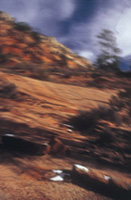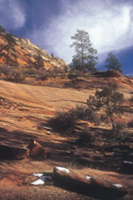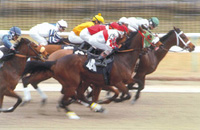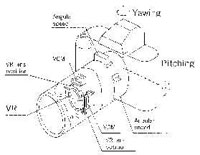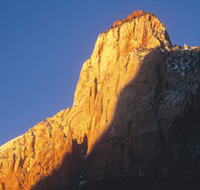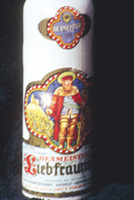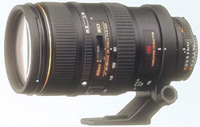AF VR Zoom Nikkor 80 to 400mm f4.5 to 5.6D ED
Nikons Vibration Reductio Entry
Although most advanced photographers use a tripod when possible, some subjects and situations call for a handheld camera. Examples include sports where full mobility is required, candid shots of people, birds in flight, and even indoor photography where flash or tripod is prohibited. Of course, there are also situations where carrying a tripod is less than practical, such as during long hikes or backpacking trips. And, anyone shooting from a boat, small airplane, or other unstable platform will find a tripod useless. In order to get sharp images, you can either shoot with a fast, more grainy, film or use some mechanism to compensate for camera movement. Nikon has addressed this issue with a new Vibration Reduction (VR) system, available in the AF VR Zoom Nikkor 80-400mm f/4.5-5.6D ED. This system is said to give you the ability to shoot at shutter speeds that are about three stops slower than would ordinarily be necessary to prevent camera shake. For example, you normally need to shoot at 1/1250 sec at a 250mm focal length to get razor sharp handheld images. With the VR system activated, you should be able to get equally sharp images at 1/60 sec, a significant advantage. Because blur from camera shake is a primary cause of unsatisfactory pictures, a VR system should help increase our photographic success ratio. The Nikon system is indeed supremely successful, as I discovered while shooting with slow slide films in Zion National Park, Utah. I often worked with the equipment handheld, and was often able to stop down to f/8 on dark, cloudy days--even when using filters--without resorting to a tripod or faster film. At this aperture, optical performance was also superior (as with any lens) and depth of field was more generous. VR Technology When VR is engaged, angular speed sensors detect minute shifts (vibrations) in camera movement. The data from the sensors is used to calculate the change in position and to drive special motors that shift the position of the dedicated VR lens element. In other words, a computer senses camera shake and shifts optical elements within the lens to counteract the effect. This works equally well in both horizontal and vertical lens orientations, but Nikon recommends turning VR off when using a tripod--unless the camera is being moved for panning or unless there is still a lot of camera shake, as on a very windy day. As with any camera shake compensating system, it's important to remember one fact. No matter how effective the technology, a moving subject will be blurred if you shoot at long shutter speeds. Hence, a faster (higher ISO film) may still be useful, especially in low light, if you want to "freeze" a subject's motion--such as a high jumper in midair or an eagle or motorcycle speeding toward you. While a system can compensate for camera shake, only a high shutter speed provides stop-action effects. |
||||
VR Advantages This feature is ideal for sports and racing photography, where you want to use a long shutter speed while moving the camera to keep pace with subjects moving across your line of vision. The subject should be fairly sharply rendered, while the background will be streaked, a convincing effect of motion in a still image. When the VR system is activated, vibration reduction is always active for the image plane; in other words, the photographs should be sharp, without blur from camera shake. However, some viewfinder image shake can occur. This troubles some photographers and creates some feeling of unease in others. Consequently, there's a VR Mode 2 setting that eliminates the VR effect in the viewfinder only. This also helps reduce battery consumption because the system becomes active only a split second before an exposure is made. |
||||
Lens Construction And Features In order to keep the cost of the lens reasonable, Nikon decided not to incorporate a Silent Wave focus motor in the barrel, so this is not an AF-S lens. Autofocus is driven by a motor in the camera body itself, as with most AF Nikkor lenses. The focus ring does not rotate during AF operation so it cannot be impeded by your hand. There is an AF/MF (Autofocus/Manual Focus) control on the barrel; press a button and rotate the ring to change focus modes. A focus range limiter switch is also provided for near or for distant subjects; this reduces focus response time for quicker focus acquisition with AF. Manual focus operation is smooth, with just the right amount of friction for a familiar feel. With a Nikon F100, autofocus was quick and fairly quiet, though not silent as with AF-S zooms. Focus is internal, so the front element does not rotate; hence the effect of a filter--such as a polarizer--does not change during focusing (or zooming). The lens does have a focusing distance scale under glass but no depth of field scale; this omission is common with most zooms, especially those with a rotary zooming mechanism like this one. Use the camera's depth of field preview to assess the approximate range of sharpness at various apertures and focal length. The optical design is entirely new, and boasts three ED (Extra-low Dispersion) glass elements to reduce secondary chromatic aberrations; this should maximize image sharpness and eliminate color fringing around subjects, even at the widest aperture at the longest focal lengths. The diaphragm has nine blades to produce a circular aperture; the advantage of this feature is most noticeable in out of focus highlights in the background of an image: they are rendered as round at all apertures, for a more natural effect. This lens is compatible with Nikon's TC-14A and TC201 tele-converters, and the VR system can operate when they are used. However, these do not maintain autofocus and Nikon's Matrix metering. Some independent-brand AF tele-converters may, but I did not have any of these for testing so cannot say how effective they are or how each one might affect image quality and other lens features. |
||||
VR Test Results In practical terms, I found that I needed to shoot at 1/500 sec without VR at a 400mm focal length to get sharp images most of the time. With VR activated, most of my images were sharp at 1/125 sec and many were equally sharp at 1/60 sec shutter speed. Bracing my elbows on a rock or the hood of my car--or using a monopod braced against some solid object--produced even more impressive results: many sharp slides were produced even at 1/30 sec at 400mm with the VR system. Is the technology perfect? No, I do have a few minor complaints. First, power consumption is increased, so the life of the camera's batteries is shortened if VR is frequently used. This is less of a problem in VR Mode 2, but I preferred the instant response of Mode 1. In order to minimize battery drain, the VR system is deactivated a few seconds after non-use. This is prudent, but the first few frames of distant hikers were unsharp. I soon learned to keep my finger on the trigger to keep the mechanism activated in such situations. In spite of this nit-picking, the system proved incredibly successful in practice, and I rarely worked without it. |
||||
Focus acquisition with most typical subjects was highly reliable, excellent in fact, when using this VR zoom with the F100. Focus tracking of trains speeding toward my position was also very good, with a series of 10 frames all sharply rendered. With erratic subjects, such as flying birds and track and field competitors, the new AF-S 300mm f/4 (or other Silent Wave lenses) might be preferable. I did not have such a lens available, so I was unable to do comparison testing. The optics of this AF VR Zoom Nikkor 80-400mm f/4.5-5.6D ED lens proved to be superb, producing high resolution and contrast. From f/8 to f/16, all images at all focal lengths were of professional caliber, with ultrahigh resolution and contrast plus excellent edge sharpness and freedom from flare and color fringing. At maximum aperture in the 80-300mm range, the lens produced excellent central sharpness, while edge sharpness was still very good. I would not hesitate to shoot at maximum aperture any time at these focal lengths. By f/8, the entire image was razor sharp, suitable for a poster-size reproduction. At the longer focal lengths, central sharpness was still very high at f/5.6, but edge sharpness benefited from stopping down to f/8. However, with the VR system, I found that I rarely needed to shoot at f/5.6, except around sunrise and sunset. And since the most significant subject is usually near the center of the frame in super telephoto images, sports and wildlife photographers should be more than happy with their photos made even at 400mm at f/5.6. Conclusion A Second Opinion This is a more challenging test than shooting objects at greater distances. At the higher magnification-1:4.8 reproduction ratio at the 400mm focal length-we all need to use higher shutter speeds because the least camera shake is magnified. Even so, at 400mm, in handheld photography, his slides made at 1/125 sec (with VR) are very sharp, while even those made at 1/30 sec are surprisingly sharp. Andy offers a rave review of the VR system: "The results were really dramatic and VR is even more effective than I had expected. When you depress the shutter release the shaking stops and you feel like you just locked a missile guidance system onto a target." Marilyn provides some general comments. She's physically small but does not find this zoom overly large or heavy. "It's light enough to easily hand hold and the zoom ring is easily adjustable while shooting a moving target," she explains. She considered the combination of focal lengths highly useful and versatile. "Being able to shift from 80mm to 400mm is a real advantage with animals, children, or sports events," she says. "I really appreciated just how useful this lens is after switching back to my 28-200mm zoom for pictures of dogs playing in a park; it was simply too short." More importantly, perhaps, she decided to buy the lens, confirming her positive evaluation of its handling and imaging qualities. |
||||
Technical Specifications |
